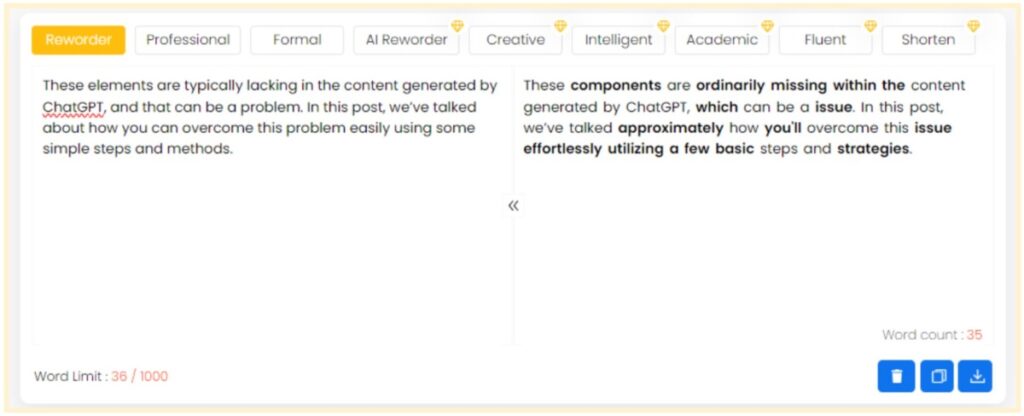ChatGPT is a great tool to use for creating content. Ever since it was released, a lot of people have taken it to be their all-in-one content planner, writer, and editor. And it makes sense, too. Using ChatGPT instead of hiring writers can save a lot of time and effort.
However, while it is a great tool and everything, it does have a concomitant downside owing to its automated software nature. The content it generates does have a human touch. It is cold and generic – even if it is told to imitate a human tone.
If you have been using ChatGPT for this purpose, you will realize what we’re referring to here.
In this post, we’re going to discuss this drawback in some detail, and then we will talk about some ways in which you can overcome it.
The Drawback of Using ChatGPT Content
To give you a good idea about this issue, we’re going to first use it to make some content and then we will show you what we mean.

In this image, you can see that we’ve given an input to create content on canonical tags, and the output clearly appears to be AI-generated. The tone is crisp and formal – and it gives off the AI look quite plainly.
Here are some of the things that we can find in this content at a glance:
- No casual or informal touch anywhere in the text
- No use of contractions
- No use of first-person or second-person language
- Lengthy sentences
- Mechanically perfect descriptive words
We must be clear on one point. These elements aren’t bad in any way. On the contrary, they make the content excellent in its conciseness and brevity, etc. But they do detract from the human touch – which is the drawback that we’re discussing in this post.
If a few of the above “robotic” elements can be done away with, the content can get a more human touch to it.
For the next part of this post, we are going to look at how you can fix the non-human nature of ChatGPT content.
How do we fix the non-human nature of ChatGPT content?
The manual method
The first method that you can follow to fix the robotic nature of ChatGPT content is to look for the robotic elements (as mentioned above) and fix them manually.
For example, here is some stuff you can do:
- You can edit the content and throw in some first-person or second-person language. For example, if ChatGPT has generated content that goes, “This particular laptop can be excellent for office use,” you can change it to “From the specs and features, we think this laptop can be great for office use.”
- Use informal and casual language where you can. Depending on the type of content you’re writing, you may not be able to do so, but where it is possible, you should add in some informal and casual language. In the example above, you can see that we used the word “great” in place of “excellent.” The word “great” is casual and informal, and it is not something that ChatGPT will use spontaneously on its own accord. A human would.
- Another thing that you can do to make the content look natural and human-like is to use contractions. This sounds like something insignificant, but it can have a big impact. For example, if the generated content goes like this, “It is a place in which there will be many problems,” or something, you can have it go: “It’s a place in which there’ll be many problems.”
The automated method
The manual method discussed above is great for making ChatGPT content look natural and all. But it takes time, and it takes effort.
Another quicker method that you can try is by using an online rewording tool. Although an online rewording tool is also a type of generative AI, it is capable of making text look more human-like if you’re smart about the one you pick and how you use it.
Rewording tools have been around for some time, and they serve a simple enough function. They reword or rephrase the content that they are provided in such a way that the meaning is not affected.
Nowadays, Rewording tools come with AI models and technologies – which helps them get all smart with their functionality. Some tools have a special mode or style to make the content look more formal. Others do the same thing, except that they make the content more human-like.
To give you an example, we’re going to use an online tool called Rewordingtool.io. Here it is:

While we can’t put our finger on it, there is something about the output that looks more human-like.
The words aren’t that point-perfect, and there is a certain (likable) clunkiness that makes it look more like the work of a human than a machine.
Conclusion
And there you have it.
What you may have guessed by reading this post is that it was not written by ChatGPT. This is the work of a human. One of the main things that gives it away is the use of normal conversational language and the imperfections that are inevitably concomitant in a human’s work.
These elements are typically lacking in the content generated by ChatGPT, and that can be a problem. In this post, we’ve talked about how you can overcome this problem easily using some simple steps and methods.


![AutoGPT…Oh my what a thing it is [S1:E4] by AI Society AutoGPT…Oh my what a thing it is [S1:E4] by AI Society](https://aigumbo.com/wp-content/uploads/2024/02/4015212-1682477251873-30d8e556c32c7-235x190.jpg)

